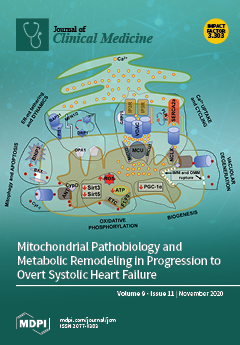This study aimed to determine diagnostic and prognostic differences in major forms of interstitial lung disease using quantitative CT imaging. A retrospective study of 225 subjects with a multidisciplinary diagnosis of idiopathic pulmonary fibrosis (IPF), interstitial pneumonia with autoimmune features (IPAF), connective tissue
[...] Read more.
This study aimed to determine diagnostic and prognostic differences in major forms of interstitial lung disease using quantitative CT imaging. A retrospective study of 225 subjects with a multidisciplinary diagnosis of idiopathic pulmonary fibrosis (IPF), interstitial pneumonia with autoimmune features (IPAF), connective tissue disease (CTD), or chronic hypersensitivity pneumonitis (cHP) was conducted. Non-contrast CT scans were analyzed using the Computer Aided Lung Informatics for Pathology Evaluation and Rating (CALIPER) program. Resulting data were analyzed statistically using ANOVA and Student’s
t-test. Univariate, multivariable, and receiver operating characteristic analyses were conducted on patient mortality data. CALIPER analysis of axial distribution on CT scans in those with IPF demonstrated greater peripheral volumes of reticulation than either CTD (
p = 0.033) or cHP (
p = 0.007). CTD showed lower peripheral ground-glass opacity than IPF (
p = 0.005) and IPAF (
p = 0.004). Statistical analysis of zonal distributions revealed reduced lower zone ground-glass opacity in cHP than IPF (
p = 0.044) or IPAF (
p = 0.018). Analysis of pulmonary vascular-related structure (VRS) volume by diagnosis indicated greater VRS volume in IPF compared to CTD (
p = 0.003) and cHP (
p = 0.003) as well as in IPAF compared to CTD (
p = 0.007) and cHP (
p = 0.007). Increased reticulation (
p = 0.043) and ground glass opacity (
p = 0.032) were predictive of mortality on univariate analysis. Increased pulmonary VRS volume was predictive of mortality (
p < 0.001) even after multivariate analysis (
p = 0.041). Quantitative CT imaging revealed significant differences between ILD diagnoses in specific CT findings in axial and, to a lesser degree, zonal distributions. Increased pulmonary VRS volume seems to be associated with both diagnosis and survival.
Full article






